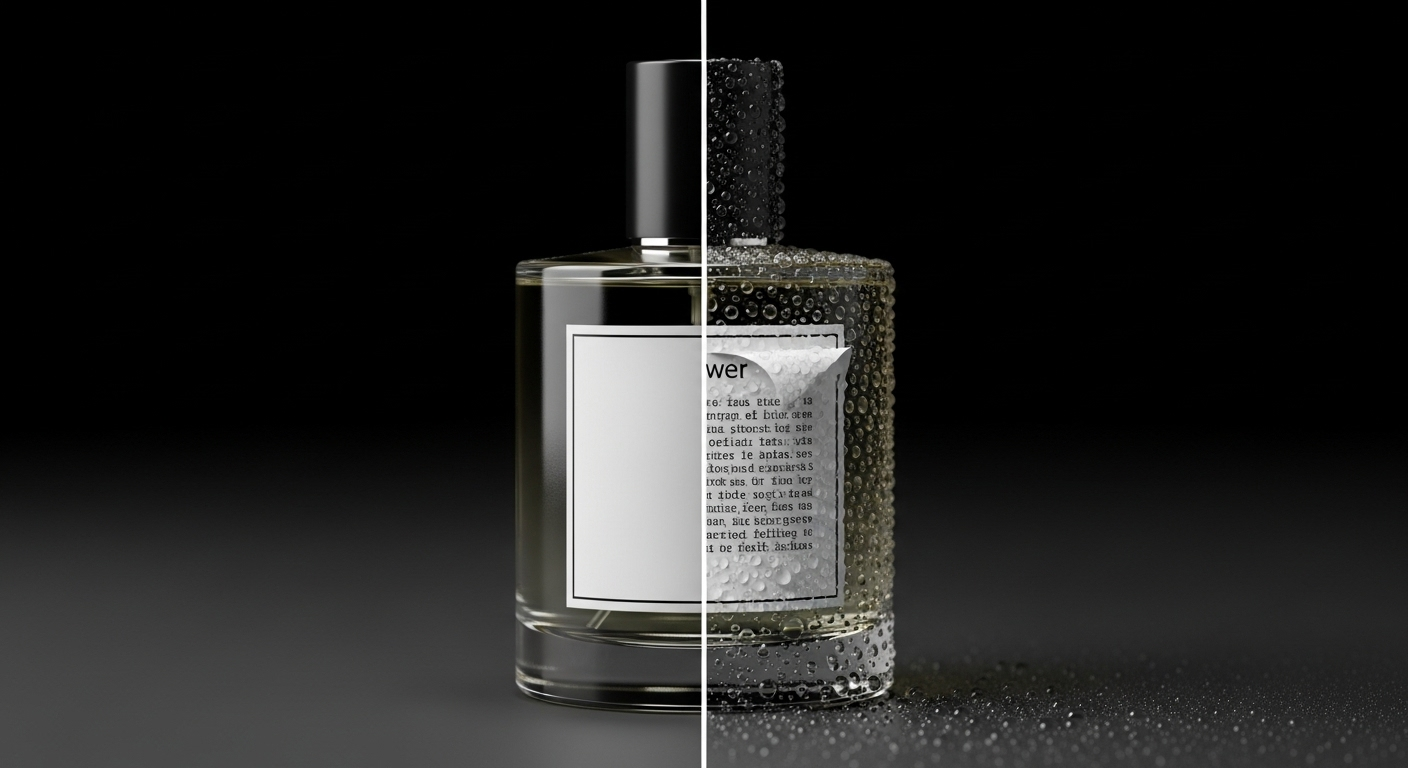You may have observed a curious phenomenon after moving a fragrance from a cool space into a warmer, more humid area: the bottle appears to “sweat,” cloaking itself in a fine sheen of moisture. This physical process, known as condensation, is often disregarded as a trivial quirk. For the discerning collector, however, this seemingly benign event is a subtle form of sabotage, capable of progressively marring a bottle’s label and aesthetic value, transforming a treasured artifact into a tired-looking object.
The event is dictated by a core tenet of physics: when air laden with moisture encounters a surface colder than its current dew point, the water vapor in that air will rapidly convert into liquid. The significant thermal mass of a glass bottle and its liquid contents provides an ideal stage for this transformation. Grasping and mitigating this straightforward physical reaction is a pivotal, if frequently ignored, element of diligent perfume collection stewardship.
The imperative to shield valuable possessions from environmental harm is a universal principle for any serious collector. This requires a forward-thinking storage strategy and a nuanced comprehension of how external forces can compromise an item’s condition. This same level of diligence applies when one considers the intrinsic nature of a perfume’s contents, such as understanding how the neurochemical perception of “hot” notes shapes the very essence of the product being preserved.
The Dew Point Dictate
At the heart of the condensation phenomenon is the concept of the dew point. This is not a static temperature but a dynamic variable, contingent on the ambient air temperature and its relative humidity. When any surface’s temperature falls to or below this dew point, the immediately surrounding air loses its capacity to hold its full moisture load in a gaseous state, forcing the excess to precipitate as liquid.
Consider a perfume bottle resting in a stable, 20°C (68°F) bedroom environment. If this bottle is then introduced into a bathroom, made warm and vaporous by a recent shower, the air might now be 26°C (79°F) with a much higher humidity level. The cool surface of the glass is now significantly below the room’s elevated dew point, triggering an immediate and visible condensation event. This abrupt thermal differential is the sole catalyst for the “sweating.”
This effect is most pronounced with bottles that are full or nearly full. The greater liquid volume functions as a thermal battery, maintaining the bottle’s cooler temperature for a longer duration. A nearly empty bottle, conversely, will equalize with the ambient temperature much faster, thus experiencing a less dramatic condensation effect.
The Gradual Decay of an Aesthetic
While the condensed water poses no threat to the glass itself, it can inflict significant damage upon the bottle’s paper label and other decorative features. The moisture penetrates the paper fibers, causing them to swell and buckle, which can lead to wrinkling, bubbling, or a complete delamination from the glass surface. This is a slow, insidious form of deterioration that can profoundly diminish the visual and collectible appeal of a fragrance.
The process of degradation unfolds through a series of stages.
- Fiber Saturation: The initial layer of condensation soaks into the paper, causing the cellulose fibers to expand and lose their structural integrity.
- Adhesive Degradation: Moisture inevitably seeps beneath the label, weakening the adhesive bond and causing the edges and corners to lift and peel.
- Ink Migration: On labels of lesser quality or advanced age, the moisture can cause the ink to bleed and feather, blurring the typography and design elements.
- Microbial Growth: Should the bottle be returned to a dark, enclosed space while still damp, the trapped moisture can foster the growth of mold or mildew, resulting in permanent staining.
This progressive decay can, over time, transform a pristine collector’s piece into an object that appears worn and uncared for, all due to a simple and preventable physical phenomenon.
The Latent Risk to the Fragrance
Although the primary damage from condensation is aesthetic, repeated and severe temperature shocks can also present a long-term risk to the perfume inside. A fine fragrance is a delicate and complex chemical solution, best maintained under stable environmental conditions. Frequent, rapid cycles of cooling and heating can serve to accelerate the oxidative degradation of the most fragile aromatic compounds, subtly altering the scent over time.
Visualize the liquid within the bottle undergoing constant thermal expansion and contraction. This process can exert minute stresses on the bottle’s seal and atomizer crimp, potentially allowing microscopic amounts of air to ingress over many cycles. The introduction of fresh oxygen is the principal adversary to a perfume’s lifespan, as it fuels the chemical reactions that cause a fragrance to spoil or “turn.”
Consequently, while a single “sweating” event is unlikely to harm the fragrance, a daily ritual of moving a bottle from a cool, stable environment to a hot, steamy one constitutes a form of slow, cumulative damage. Maintaining thermal equilibrium is the cardinal rule for the long-term archival of a perfume collection.
A Proactive Preservation Strategy
The prevention of condensation and the protection of your collection is a matter of straightforward environmental management. The objective is to shield your perfume bottles from swift and extreme fluctuations in both temperature and humidity. This is a foundational principle of archival science, as relevant to a fragrance collection as it is to a library of rare books.
The most prudent strategy is to select a permanent storage location for your collection that remains cool, dark, and has a relatively stable humidity level. A drawer in a bedroom dresser or a dedicated cabinet in a living area are far superior choices. The bathroom is, unequivocally, the most hostile environment for perfume storage due to its relentless and extreme environmental swings.
If you find it necessary to move a bottle into a warmer space, allow it to acclimate gradually. Rather than transferring it directly from a cool closet to a hot bathroom, let it rest for a time in an intermediate space. This simple buffering step can markedly reduce the thermal shock, thereby minimizing the potential for condensation to form.
Frequently Asked Questions
While this is a frequently suggested tactic, it is generally ill-advised for fragrances that are in regular use. The profound cold can sometimes cause the precipitation or solidification of certain natural waxes and resins within the perfume oil. More significantly, the daily thermal shock of moving the bottle from a cold refrigerator to your warm skin can inflict more cumulative damage than simply storing it at a stable, cool room temperature.
Yes, though the direct consequences may differ. Condensation will form on any surface whose temperature is below the dew point, including aluminum or plastic. While the moisture will not damage the bottle material itself, it can still ruin an applied paper label. The fundamental physical process remains the same regardless of the vessel’s material.
Repairing a moisture-damaged paper label without causing further harm is an exceptionally delicate task. For a truly valuable or sentimental bottle, seeking the advice of a professional paper conservator would be the wisest course of action. For a standard bottle, one could attempt to re-adhere peeling corners with a micro-application of archival-quality glue, but this is a high-risk procedure.

